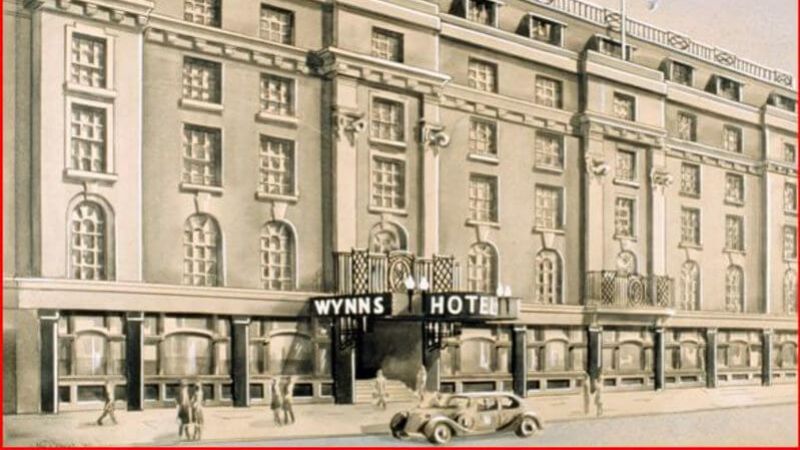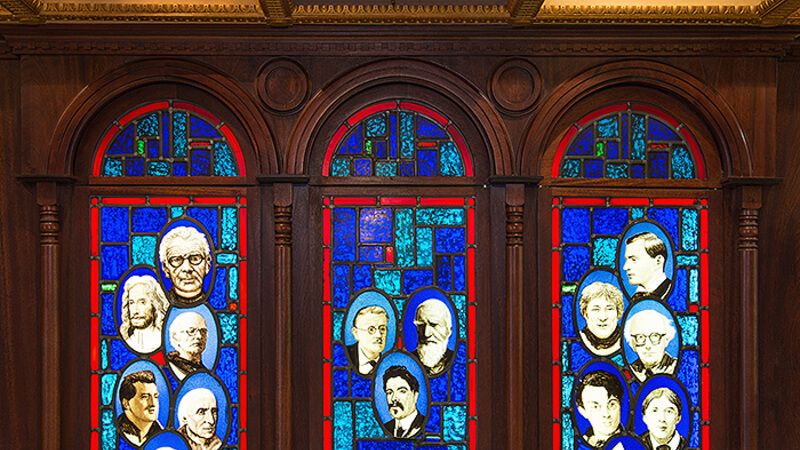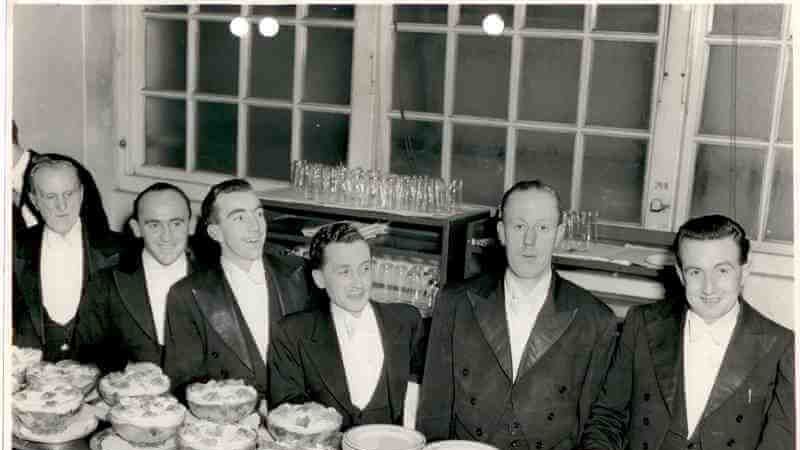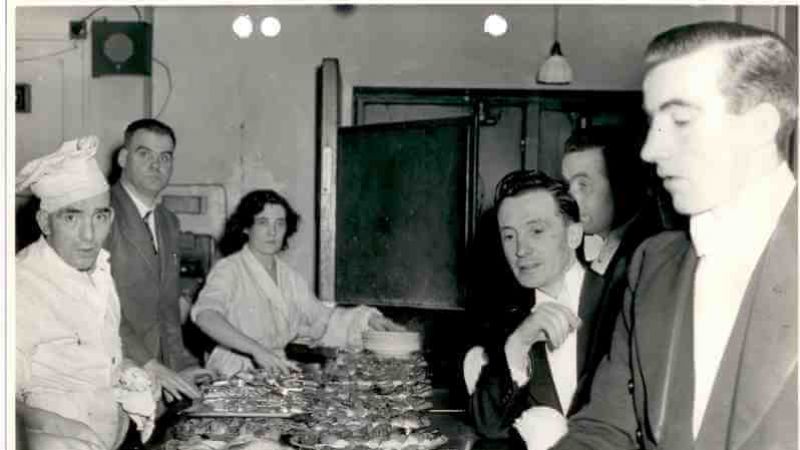WYNN’S PLACE IN IRISH HISTORY
Wynn's Hotel has been in existence in one form or another since 1845 and has witnessed many of the events which have shaped the history of Dublin City. Built in 1845, bombed during the 1916 rising and rebuilt in 1921 using mass concrete, the only building in Dublin to do so at this time.
Our close link with the Abbey Theatre and Miss Phoebe Wynn's, (the Proprietor at the time), connections with many famous literary figures from home and abroad ensured the Hotel was always a hub of activity and a central meeting place for many of the characters who tread the boards of The Abbey stage.
In 1913 one of the most memorable historical events took place in our Saints & Scholars lounge - The first meeting to establish 'The Irish Volunteer Force', chaired by Eoin Mac Neil, a Professor in UCD and attended by Padraig Pearse & The O’Rahilly.
Wynn's Hotel is very proud to have been part of such memorable and historical events that have shaped our Country and to mark both of the events mentioned you will find 2 brass plaques hung in our Saints & Scholars Lounge.
1845 - WYNN'S HOTEL OPENING
WYNN'S HOTEL opened its doors in 1845 as a commercial boarding house under the ownership of Ms. Phoebe Wynn. Unfortunately, little is known of Phoebe Wynn except that her ownership lasted only seven years but her name lived on through several changes of ownership. Phoebe Wynn had a lot of pull with the Church of Ireland clergy and they arrived in their droves, not just for accommodation but to dine and meet up with friends and family as the Hotel was and still is in one of the most central locations in Dublin City. Ironically Wynn’s first address was 33 Lower Abbey St which had previously been The Church of Ireland rectory of the parish of St Thomas. With a change of ownership, its religious orientation shifted and it became the favoured city haunt of the Catholic clergy up from the country.
1897 - HOTEL NAME CHANGED
Wynn’s Hotel continued to prosper with a few changes of ownership and by the end of the century the Hotel occupied numbers 35, 36, 37, 38 and 39 Lower Abbey Street.
The Hotel's name changed to Telford’s during a successive ownership from 1878 until 1897 but the name reverted to Wynn's when it was acquired by the Clarence Hotel Co. Ltd in 1898 and has remained until present, the name has such a place in Dublin’s History that it would only be fatal to try and meddle with it ever again. In 1904 The Abbey Theatre was founded by W.B. Yeats and Lady Augusta Gregory, the close proximity to Wynn’s Hotel made it the perfect spot for playwrights, actors and Dublin’s artistic community. Lady Gregory and W.B. Yeats often took up residence in the public rooms of Wynn’s Hotel.
In June of 1897 James Connolly organised an anti-Jubilee rally, the rally was addressed by Maud Gonne, both of whom where regular patrons of Wynn’s Hotel. On the day of the Jubilee James Connolly and Maud Gonne organised a funeral procession through Dublin City – the coffin that was carried was marked ‘British Empire’, Trinity College students tried to disrupt the rally with shouts of ‘God Save Our Queen’ but were repelled by the crowd. W.B. Yeats, who was attending another commemoration in the City, joined in on James Connolly’s rally. The coffin was thrown into the River Liffey with Connolly shouting ‘Here goes the coffin of the British Empire. To hell with the British Empire’. The James Connolly Memorial Statue is only a 10-minute walk from Wynn’s Hotel.
Our close link with the Abbey Theatre and Miss Phoebe Wynn's, (the Proprietor at the time), connections with many famous literary figures from home and abroad ensured the Hotel was always a hub of activity and a central meeting place for many of the characters who tread the boards of The Abbey stage.
1913 - THE IRISH VOLUNTEERS
On the 11th of November 1913 at a meeting held in the hotel, a decision was taken to establish 'The Irish Volunteers'. The original meeting was arranged by Eoin MacNeill, a professor in UCD at the time and Michael O'Rahilly, (The O'Rahilly), a man of independent means who was very active in the Gaelic League. At the meeting under Mac Neill's chairmanship it was decided to establish an Irish Volunteer force. Others in attendance were Padraig Pearse, Eamonn Ceannt and Sean Mac Diarmada. This historical meeting changed the course of Irish History and we are very proud to be able to say it took place in Wynn’s Hotel.
Within a few hours of the meeting being held in Wynn's, detectives from Dublin Castle called on the Manager of the Hotel to warn him not to allow further meetings of this kind - this warning seems to have been ignored as the committee met in Wynn's on several occasions to plan the public inauguration of the 'Irish Volunteers'.
This historical meeting changed the course of Irish History and we are very proud to be able to say it took place in Wynn’s Hotel. In our Saints & Scholars Lounge you will see a plaque erected to commemorate this event alongside another to show the first meeting of Cumann na mBan.
In January 1913, the British House of Lords had rejected a Bill which proposed Home Rule for Ireland. Nevertheless, it seemed that the agitation for Home Rule which had begun forty years earlier must soon bear fruit. Those in the North who were bitterly opposed to any weakening of the 'Union of Great Britain and Ireland' had established an armed force - 'The Ulster Volunteers', and were threatening rebellion if an all-Ireland Government were set up in Dublin. Nationalists began to realise the need for action to defend their rights.
A newspaper commentary on the political situation in Ireland by Professor Eoin Mac Neill of University College Dublin, himself an Ulsterman, was rejected by many as a call to arms. The suggestion that Mac Neill should take the lead in the establishment of an Irish Volunteer force is said to have been made by a Belfast Quaker, Bulmer Hobson. Hobson, a political journalist working in Dublin, was the local head of the Irish Republican Brotherhood - a secret organisation which aimed at the establishment of an Irish Republic. The O'Rahilly, a man of independent means, who was very active in the Gaelic League, after discussions with Mac Neill and Hobson, invited a small group to meet in Wynn's Hotel on 11th of November 1913. At the meeting, under Mac Neill's chairmanship, it was decided to establish an Irish Volunteer force. Of the small group who attended, four died as a result of 1916 - Pearse, Ceannt, Mac Diarmada and The O'Rahilly. Though he did not become a member of the Provisional Committee in 1913, Sir Roger Casement was one of those who inspired Eoin Mac Neill at this time. Within a few hours of the holding of the meeting in Wynn's, detectives from Dublin Castle called on the manager of the hotel to warn him not to allow further meetings of this kind on the premises. This warning seems to have been ignored. A provisional committee representative of all degrees of nationalist opinion was established immediately. The committee met in Wynn's Hotel on several occasions to plan the public inauguration of the 'Irish Volunteers', whose aim it would be "to secure and maintain the rights and liberties of all the people of Ireland." On the 25th of November, 1913, Ireland's modern army was established by acclamation at a huge public meeting in the Rotunda Rink which stood in the grounds now occupied by The Garden of Remembrance, Parnell SQ.
Even with all the disruption and chaos in the City The Clarence Hotels Company Ltd showed a net profit for the year of 1913 to be £3,292 2 9. The Companies auditors at the time were Messrs. Craig, Gardner & Co.
In August of 1913 Dublin also experienced one of the bitterest labour disputes ever seen in Ireland or Britain, it was referred to as the ‘Lockout’. James Larkin, whose statue can be seen close to Wynn’s Hotel on Dublin’s O’Connell St, formed the Irish Transport and General Workers Trade Union – his aim was to win improvements in working conditions and wages for skilled and unskilled workers via negotiation and strikes. William Murphy, owner of the Dublin Tram Co., vowed to sack or ‘lockout’ any worker who became a member of this Trade Union. The Lockout lasted 6 months after which most workers for the sake of their starving families returned to work and closed membership with the Union.
*On the 11 November 2013, Wynn's Hotel celebrated the Centenary of the 1st ever meeting of the Irish Volunteers which was held in the Hotel on 11 November 1913. Guest speaker on the night was Eunan O’Halpin Trinity College Dublin.
1914 - CUMANN NA MBAN
The inaugural public meeting of Cumann na mBan was held in Wynn’s Hotel, Thursday, 2 April 1914. It was presided over by Agnes O’Farrelly, who was elected President. The provisional executive unveiled at the meeting included Jennie Wyse Power, Nancy O’Rahilly, Agnes MacNeill, Margaret Dobbs, Mary Colum, Nurse McCoy, Louise Gavan Duffy and Elizabeth Bloxham. A constitution was adopted which stated that Cumann na mBan aimed: 1. To advance the cause of Irish liberty 2. To organise Irishwomen in the furtherance of this object 3. To assist in arming and equipping a body of Irishmen for the defence of Ireland 4. To form a fund for these purposes to be called the ‘Defence of Ireland Fund’. In September 1914 the ‘Home Rule Bill’ was passed but not without much resistance from the Unionists community who formed the UVF, a private army. Ireland was on the brink of Civil War but the outbreak of World War 1 put a stop to this and many nationalists joined the British Army, most of whom were from working class areas where the unemployment rate was very high.
1916 - RISING
In April 1916 an army of Irish Republicans under Padraig Pearse’s command staged the Easter Rising, they no longer wanted Home Rule but a full independence for The Irish Republic. James Connolly had formed a smaller group known as the Irish Citizen Army who joined forces with the Irish Volunteers, together they took over the strong holds in Dublin City. The GPO (General Post Office), only a stone throw from Wynn’s Hotel, became the headquarters for the rebel forces.
During the 1916 rising a street barricade, which had been erected outside, Wynn's was set on fire by incendiary bullets. A rebel volunteer on the roof of the GPO later recalled how he saw mean and women “sitting in the windows of Wynn’s Hotel in Lwr Abbey St, watching the battle as from a theatre seat”. Then, what began as entertainment for the guests turned dangerous. Under bombardment from British artillery, Wynn’s caught fire, the fire spread from the barricade to the timber facings of the hotel and when guest and staff lives were threatened, they left the hotel under the protection of a makeshift white flag and found refuge in The Clarence Hotel. They had succeeded in getting there by Butt Bridge and the South Quays under the protection of the improvised white flag.
Wynn’s was destroyed after the fire and the re-build did not start until 1921.
485 people were killed in the Easter Rising. About 54% were civilians, 30% were British military and police, and 16% were Irish rebels. More than 2,600 were wounded. Many of the civilians were killed because of the British using artillery and heavy machine guns, or mistaking civilians for rebels. Others were caught in the crossfire in a crowded city. The shelling and the fires it caused left parts of Dublin City in ruins.
In December 1918, republicans, now members of the newly reformed Sinn Féin party, won a landslide victory in the general election to the British Parliament. Rather than take their seats, they instead convened the First Dáil and declared the independence of the Irish Republic, which led to the War of Independence.
1926 - CLARENCE HOTEL COMPANY
Wynn's Hotel was rebuilt in 1926 and was one of the first buildings in Dublin to use mass concrete, it continued in the ownership of the Clarence Hotel Company. 1926 also marked the first ever census of the population of the Irish Free State and while Wynn's rose out of the ashes another landmark was due to be demolished, Nelson's Pillar was to be removed from O'Connell street as ordered by Dublin City Council but no approval had been given by the Oireachtas...it survived until 1966 when it was destroyed by a bomb planted by Irish Republicans. The Clarence Hotel and Wynn's Hotel operated as joint ventures both with completely different styles and clientele. Staff at the time would have said that The Clarence was the favoured child of the family. In 1992 the two old ladies parted ways when the current owners decided to sell The Clarence to U2 Lead Singer Bono and the Lead Guitarist The Edge.
1936 - HISTORICAL MEETING AT WYNN'S HOTEL
Another historical meeting held in Wynn’s Hotel, at this time Sean Lemass was Minister for Industry and Commerce. This meeting was one year before Eamon de Valera became Taoiseach and 10 years after he and Sean Lemass resigned from Sinn Fein, both where founding members of Fianna Fail. Under De Valera's leadership Fianna Fail won further general elections in 1937, 1938, 1943 and 1944.
1973 - JOHN LOFTUS BECOMES MANAGING DIRECTOR OF WYNN'S
John Loftus becomes Managing Director of the company which was then under the same ownership as the Clarence Hotel on Wellington Quay. Both hotels once attracted similar clientele, upstanding country folk but their paths diverged when the Loftus family sold the Clarence to a consortium involving Irish Rock Band U2 in 1992. The Loftus Family, albeit a different generation, continue as owners of Wynn's Hotel Dublin. The traditional style is still maintained throughout the Hotel while also allowing us to move into the 21st Century to meet our guest's needs. Wynn's is still a listed building and is part of an Architectural Conservation Area.
1992 - JOHN & CONNIE LOFTUS
Wynn’s was purchased outright by John & Connie Loftus, whose aim it is to continue the tradition of hospitality and service, which began in 1845. To this day it remains one of the very few and probably oldest family Hotel still in operation in Dublin. Our staff have earned an excellent repution in Service, with many of our regular Clients commenting that it is like " home from home".
1996 - MICHAEL COLLINS
Wynn’s was used as a location for Neil Jordan’s film “Michael Collins”. Wynn's played such an integral part in Dublin's History. It stood tall during "The Dublin Lockout and was destroyed by incendiary fire during the 1916 Easter Rising. It has been used many times for various film locations with esteemed Directors such as Neil Jordan, Steven Soderbergh and Jim Sheridan all fulfilling the vision of their movies in Wynn's Hotel.
1997 - THE BOXER
Once again Wynn’s was used as a main backdrop for Jim Sheridan’s movie “The Boxer” in 1997 with Oscar winning actor Daniel Day-Lewis taking on the role of Belfast native Danny Flynn. Wynn's Hotel has a strong connection with the Arts Community and its links with The Abbey Theatre has been growing since it opened its doors in 1904 with founders Lady Gregory and W.B. Yeats often meeting in Wynn's Hotel. We have maintained this relationship and often in among our regular guests in the renowned "Saints & Scholars Lounge" you can spot some familiar famous faces.
2011 - CITY OF WORDS PROGRAMME
In 2010 Dublin was designated a UNESCO City of Literature in recognition of its cultural profile and international standing as a city of literary excellence. It was one of four cities to be awarded this distinction. In light of this Wynn's Hotel was asked to be an Ambassador for the City of Words programme and an official partner of Dublin UNESCO City of Literature. We were honoured to receive this title along with only 12 other businesses in Dublin. Hugh Leonard, the late playwright once nurtured a crazed vision of Wynn's Hotel. He imagined that if he looked behind a sofa, (obviously in our Saints & Scholars Lounge), he would find the great lyricist Percy French singing "Are ye right there, Michael?"... "It is surely clear that to describe Dublin as a City of Literature would be like saying rain sometimes falls in Ireland".....Joseph O'Connor - author of Star of the Sea.
TODAY
Today Wynn's is a family run concern, probably one of the longest in Dublin still operating. We are keen to preserve the emphasis on personal attention and friendly service that has long been the hallmark of the establishment. With it's traditional bars and lounges, superbly prepared food, delightful bedrooms and its downtown location close to fashionable shopping areas, theatres, cinemas and places of interest Wynn's Hotel is your ideal address when visiting Dublin.
"Being in business since 1845 doesn't make Wynn's one of the best Hotel's in Dublin, its by being one of the best Hotel's that Wynn's continues to thrive"
"It does not pander to culinary fashions and unlike more modish competitors, one of Dublin's best-known hotels is making a profit"....Irish Independent
"RTE to take over O'Connell St for 'Road to the Rising Event'. Wynn's Hotel will host RTE presenters Miriam OCallaghan and David McCullagh who will be introducing a series of talks"... Irish Times
